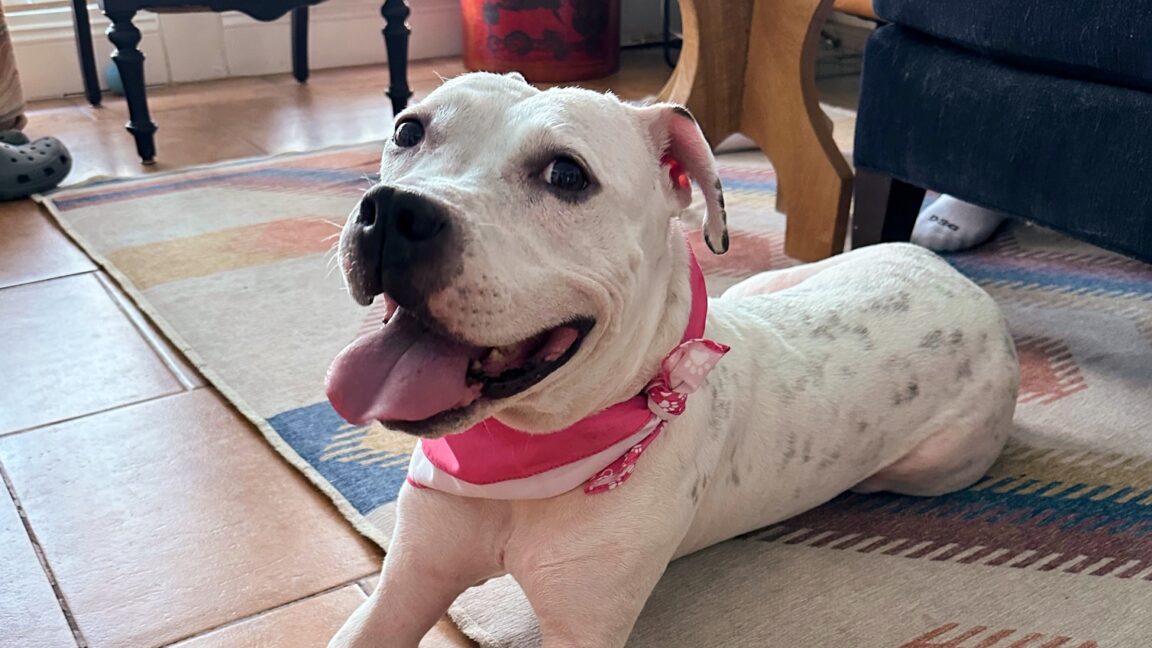I helped a lost dog’s AirTag ping its owner: An ode to replaceable batteries
A successful game of fetch
I helped a lost dog’s AirTag ping its owner: An ode to replaceable batteries
The most repair-friendly device Apple makes needs to stick with coin batteries.
Kevin Purdy
–
May 21, 2025 5:31 pm
|
24
This is Serene, a 7-year-old pitbull mix available for adoption at the Humane Rescue Alliance in Washington, DC.
Credit:
Humane Rescue Alliance
This is Serene, a 7-year-old pitbull mix available for adoption at the Humane Rescue Alliance in Washington, DC.
Credit:
Humane Rescue Alliance
Story text
Size
Small
Standard
Large
Width
*
Standard
Wide
Links
Standard
Orange
* Subscribers only
Learn more
Out of all the books I read for my formal education, one bit, from one slim paperback, has lodged the deepest into my brain.
William Blundell's The Art and Craft of Feature Writing offers a "selective list of what readers like." It starts with a definitive No. 1: "Dogs, followed by other cute animals and well-behaved small children." People, Blundell writes, are your second-best option, providing they are doing or saying something interesting.
I have failed to provide Ars Technica readers with a dog story during nearly three years here. Today, I intend to fix that. This is a story about a dog, but also a rare optimistic take on a ubiquitous "smart" product, one that helped out a very good girl.
Note: The images in this post are not of the aforementioned dog, so as to protect their owner's privacy. The Humane Rescue Alliance of Washington, DC, provided photos of adoptable dogs with some resemblance to that dog.
Hello, stranger
My wife and I were sitting with our dog on our front porch on a recent weekend morning. We were drinking coffee, reading, and enjoying DC's tiny window for temperate spring weather. I went inside for a moment; when I came back, my dog was inside, but my wife was not. Confused, I cracked open the door to look out. A dog, not my own, stuck its nose into the door gap, eager to sniff me out.
"There's a dog here?" my wife said, partly to herself. "She just ran up on the porch. I have no idea where she came from."
Rexi, a nearly 3-year-old mixed breed, is being fostered and ready for adoption at the Humane Rescue Alliance. The author's wife thinks Rexi looks the most like their unexpected dog visitor.
Credit:
Humane Rescue Alliance
Rexi, a nearly 3-year-old mixed breed, is being fostered and ready for adoption at the Humane Rescue Alliance. The author's wife thinks Rexi looks the most like their unexpected dog visitor.
Credit:
Humane Rescue Alliance
I secured my dog inside, then headed out to meet this fast-moving but friendly interloper. She had a collar, but no leash, and looked well-groomed, healthy, and lightly frantic. The collar had a silicone band on it, holding one of Apple's AirTags underneath. I pulled out the AirTag, tapped it against my phone, and nothing happened.
While my wife posted on our neighborhood's various social outlets, I went into the garage and grabbed a CR2032 battery. That's not something everyone has, but I have a few AirTags, along with a bit of a home automation habit. After some pressing, twisting, and replacing, the AirTag beeped and returned to service.
I tapped the AirTag against my phone, this time receiving a link to a webpage with the tag's serial number and the last four digits of its owner's phone number. I had not yet needed to actually find something truly lost with an AirTag, so I looked up how it worked. Once you set an AirTag in your Apple account to "Lost" status, you can then choose to have a full phone number and message appear to anybody who taps it with their device. If you don't know that your AirTag or Find-My-compatible item is missing and mark it that way, you can't preemptively have it offer up details. Maybe Apple should change that, for certain kinds of tracking.
Noma, a 1-year-old pit bull mix, at the Humane Rescue Alliance.
Credit:
Humane Rescue Alliance
Noma, a 1-year-old pit bull mix, at the Humane Rescue Alliance.
Credit:
Humane Rescue Alliance
I had to leave the house, leaving my wife to negotiate space and sight lines between our concerned, confused dog and this excited newcomer. The local animal control encouraged my wife to monitor social channels before dropping the dog off at their facility. After two hours of unexpected fostering, we were anxiously texting one another. We were glad to have gotten this dog off the street and into a home with leashes and a crate available, but we had to make a decision before the animal shelter closed for the day.
Then the doorbell rang. The dog's owner, led by the AirTag, asked if we had her dog. She explained how the dog got loose and pledged to keep a fresh battery in there from now on. My wife said goodbye to her temporary charge, and I came home to find both her and my dog far more relaxed.
Maybe the dog's owner would have seen postings on Facebook or Nextdoor, though I cannot blame anybody who doesn't want those networks in their life. Perhaps a neighborhood phone chain would have come through, or the shelter could have connected us. But Apple's coin battery-powered nub came through in the nick of time, and I'm grateful.
That’s a good AirTag—now, stay
Cresha, a 3-year-old mixed-breed dog, is available for adoption.
Credit:
Humane Rescue Alliance
Cresha, a 3-year-old mixed-breed dog, is available for adoption.
Credit:
Humane Rescue Alliance
I was working at iFixit when rumors circulated about Apple developing a "Tile-like" item tracker in early 2019. The teardown and communications teams at iFixit were largely expecting Apple to release another tiny product that was impossible to fix or have its batteries swapped, filling the gaps in landfills alongside AirPods. Tile, one of the first in the Bluetooth tracking market, had introduced replaceable batteries a few months prior. But Apple, at that point still defending its butterfly MacBook keyboards and holding tight to Lightning ports, seemed unlikely to go the way of the common denominator.
But Apple chose wisely. After addressing some of the early concerns about their potential misuses, AirTags have become very handy devices. Some dog owners go for GPS tracker collars, which might fare better in rural areas. But it's a good bet that somebody with an iPhone will get close enough to your dog—or wallet, or keys—to update its location. Even if they don't have an iPhone to provide a location ping, they can get some information on who owns this tag.
Apple is seemingly gearing up to offer a new AirTag, one with purportedly greater range and fewer avenues for privacy-invading misuse. I humbly request that the new model continue to be powered by a coin cell battery. When something important goes missing—especially something that likes ear scritches and pumpkin treats—it is best not to have to find a charging cable or magnetic charging pad, or discover the cells inside are dead. Coin cells are not perfectly recyclable, because nothing really is, but they're generally much easier to handle than lithium-ion waste.
I have AirTags on my family's bikes, keys, wallets, and a couple other things. Depending on what the next AirTag looks like, I'm keen to get one on my dog's collar, too. Take the battery warnings seriously, and they can help some wayward good boys and girls. And I hope they made this human, telling a story about coin batteries, momentarily interesting.
Kevin Purdy
Senior Technology Reporter
Kevin Purdy
Senior Technology Reporter
Kevin is a senior technology reporter at Ars Technica, covering open-source software, PC gaming, home automation, repairability, e-bikes, and tech history. He has previously worked at Lifehacker, Wirecutter, iFixit, and Carbon Switch.
24 Comments
#helped #lost #dogs #airtag #ping
I helped a lost dog’s AirTag ping its owner: An ode to replaceable batteries
A successful game of fetch
I helped a lost dog’s AirTag ping its owner: An ode to replaceable batteries
The most repair-friendly device Apple makes needs to stick with coin batteries.
Kevin Purdy
–
May 21, 2025 5:31 pm
|
24
This is Serene, a 7-year-old pitbull mix available for adoption at the Humane Rescue Alliance in Washington, DC.
Credit:
Humane Rescue Alliance
This is Serene, a 7-year-old pitbull mix available for adoption at the Humane Rescue Alliance in Washington, DC.
Credit:
Humane Rescue Alliance
Story text
Size
Small
Standard
Large
Width
*
Standard
Wide
Links
Standard
Orange
* Subscribers only
Learn more
Out of all the books I read for my formal education, one bit, from one slim paperback, has lodged the deepest into my brain.
William Blundell's The Art and Craft of Feature Writing offers a "selective list of what readers like." It starts with a definitive No. 1: "Dogs, followed by other cute animals and well-behaved small children." People, Blundell writes, are your second-best option, providing they are doing or saying something interesting.
I have failed to provide Ars Technica readers with a dog story during nearly three years here. Today, I intend to fix that. This is a story about a dog, but also a rare optimistic take on a ubiquitous "smart" product, one that helped out a very good girl.
Note: The images in this post are not of the aforementioned dog, so as to protect their owner's privacy. The Humane Rescue Alliance of Washington, DC, provided photos of adoptable dogs with some resemblance to that dog.
Hello, stranger
My wife and I were sitting with our dog on our front porch on a recent weekend morning. We were drinking coffee, reading, and enjoying DC's tiny window for temperate spring weather. I went inside for a moment; when I came back, my dog was inside, but my wife was not. Confused, I cracked open the door to look out. A dog, not my own, stuck its nose into the door gap, eager to sniff me out.
"There's a dog here?" my wife said, partly to herself. "She just ran up on the porch. I have no idea where she came from."
Rexi, a nearly 3-year-old mixed breed, is being fostered and ready for adoption at the Humane Rescue Alliance. The author's wife thinks Rexi looks the most like their unexpected dog visitor.
Credit:
Humane Rescue Alliance
Rexi, a nearly 3-year-old mixed breed, is being fostered and ready for adoption at the Humane Rescue Alliance. The author's wife thinks Rexi looks the most like their unexpected dog visitor.
Credit:
Humane Rescue Alliance
I secured my dog inside, then headed out to meet this fast-moving but friendly interloper. She had a collar, but no leash, and looked well-groomed, healthy, and lightly frantic. The collar had a silicone band on it, holding one of Apple's AirTags underneath. I pulled out the AirTag, tapped it against my phone, and nothing happened.
While my wife posted on our neighborhood's various social outlets, I went into the garage and grabbed a CR2032 battery. That's not something everyone has, but I have a few AirTags, along with a bit of a home automation habit. After some pressing, twisting, and replacing, the AirTag beeped and returned to service.
I tapped the AirTag against my phone, this time receiving a link to a webpage with the tag's serial number and the last four digits of its owner's phone number. I had not yet needed to actually find something truly lost with an AirTag, so I looked up how it worked. Once you set an AirTag in your Apple account to "Lost" status, you can then choose to have a full phone number and message appear to anybody who taps it with their device. If you don't know that your AirTag or Find-My-compatible item is missing and mark it that way, you can't preemptively have it offer up details. Maybe Apple should change that, for certain kinds of tracking.
Noma, a 1-year-old pit bull mix, at the Humane Rescue Alliance.
Credit:
Humane Rescue Alliance
Noma, a 1-year-old pit bull mix, at the Humane Rescue Alliance.
Credit:
Humane Rescue Alliance
I had to leave the house, leaving my wife to negotiate space and sight lines between our concerned, confused dog and this excited newcomer. The local animal control encouraged my wife to monitor social channels before dropping the dog off at their facility. After two hours of unexpected fostering, we were anxiously texting one another. We were glad to have gotten this dog off the street and into a home with leashes and a crate available, but we had to make a decision before the animal shelter closed for the day.
Then the doorbell rang. The dog's owner, led by the AirTag, asked if we had her dog. She explained how the dog got loose and pledged to keep a fresh battery in there from now on. My wife said goodbye to her temporary charge, and I came home to find both her and my dog far more relaxed.
Maybe the dog's owner would have seen postings on Facebook or Nextdoor, though I cannot blame anybody who doesn't want those networks in their life. Perhaps a neighborhood phone chain would have come through, or the shelter could have connected us. But Apple's coin battery-powered nub came through in the nick of time, and I'm grateful.
That’s a good AirTag—now, stay
Cresha, a 3-year-old mixed-breed dog, is available for adoption.
Credit:
Humane Rescue Alliance
Cresha, a 3-year-old mixed-breed dog, is available for adoption.
Credit:
Humane Rescue Alliance
I was working at iFixit when rumors circulated about Apple developing a "Tile-like" item tracker in early 2019. The teardown and communications teams at iFixit were largely expecting Apple to release another tiny product that was impossible to fix or have its batteries swapped, filling the gaps in landfills alongside AirPods. Tile, one of the first in the Bluetooth tracking market, had introduced replaceable batteries a few months prior. But Apple, at that point still defending its butterfly MacBook keyboards and holding tight to Lightning ports, seemed unlikely to go the way of the common denominator.
But Apple chose wisely. After addressing some of the early concerns about their potential misuses, AirTags have become very handy devices. Some dog owners go for GPS tracker collars, which might fare better in rural areas. But it's a good bet that somebody with an iPhone will get close enough to your dog—or wallet, or keys—to update its location. Even if they don't have an iPhone to provide a location ping, they can get some information on who owns this tag.
Apple is seemingly gearing up to offer a new AirTag, one with purportedly greater range and fewer avenues for privacy-invading misuse. I humbly request that the new model continue to be powered by a coin cell battery. When something important goes missing—especially something that likes ear scritches and pumpkin treats—it is best not to have to find a charging cable or magnetic charging pad, or discover the cells inside are dead. Coin cells are not perfectly recyclable, because nothing really is, but they're generally much easier to handle than lithium-ion waste.
I have AirTags on my family's bikes, keys, wallets, and a couple other things. Depending on what the next AirTag looks like, I'm keen to get one on my dog's collar, too. Take the battery warnings seriously, and they can help some wayward good boys and girls. And I hope they made this human, telling a story about coin batteries, momentarily interesting.
Kevin Purdy
Senior Technology Reporter
Kevin Purdy
Senior Technology Reporter
Kevin is a senior technology reporter at Ars Technica, covering open-source software, PC gaming, home automation, repairability, e-bikes, and tech history. He has previously worked at Lifehacker, Wirecutter, iFixit, and Carbon Switch.
24 Comments
#helped #lost #dogs #airtag #ping
·36 Visualizações








